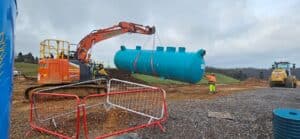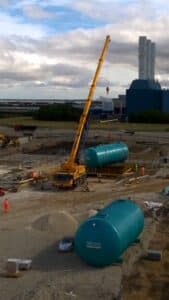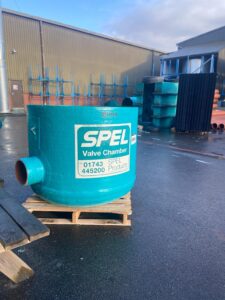At A Glance:
- Location : Near Hull, East Yorkshire (Dogger Bank A&B) and Near Redcar (Dogger Bank C)
- Client: SSE Renewables (40%), Equinor (40%) and Vårgrønn (20%)
- Consultant: Doran Consulting
- Contractor: Varied across sites
Products Supplied:
Models Supplied:
- 3no. P015/1CSC and 3no. P004/1CSC
- Small Puraceptors supplied for a small catchment area on a high risk area of the site
- National Grid approved full retention separator often used on substation sites.
Models supplied:
- 3no. TS300/18200 and 1no. TS400/60000
- Holding tanks for storing foul water which can then be collected by a vacuum tanker or similar.
Models supplied:
- TS200/1000
- Only 1,000 litre capacity for capturing small, infrequent spillages at special refuelling areas.
- Often supplied with a CR (Chemical Resistant) or HCR (Highly Chemical Resistant) liner for chemical spillages.
Models supplied:
- PPS500/150000
- 150,000 litre below ground storage tank factory fitted with oil/water sensitive pumps for bund water control.

Dogger Bank Wind Farm is an offshore wind farm being developed in three phases – Dogger Bank A, B and C – located around 150km from the North East coast of England. Once all 3 phases are finished, this will be the world’s largest offshore wind farm. Combined, they will have an installed capacity of 3.6GW, equivalent to powering up to 6 million homes annually.
The Dogger Bank offshore wind farm is a joint venture between SSE Renewables (40%), Equinor (40%) and Vårgrønn (20%). One rotation of the turbines, which are GE’s Haliade-X turbine, can power a UK household for two days and with 277 turbines, the whole development will save the equivalent of almost 2.5 million vehicles’ emissions in a year.
As the project was split into 3 phases, SPEL provided each of the SPEL specified products 3 times to each of the phases. SPEL provided two sizes of Puraceptor full retention separators, 3no. P015/1CSC and 3no. P004/1CSC, which were used on relatively small catchment areas of high risk pollution.
As is often done on substations and similar, cesspool tanks are used for collecting the sewage waste from the site as the toilets and other waste water applicances are relatively infrequently used and because there is no connection to a foul water sewer. The cesspools simply store the waste for removal by a vacuum tanker or similar. SPEL provided 3no. SPEL Tankstor 18,200 litre cesspools for the site, plus a large SPEL Tankstor 60,000 litres cesspool for the temporary site compound.
Also from our SPEL Tankstor range, 3no. 200 Series (1.2m dia.), 1000 litre capacity tanks were used as blind tanks to capture small infrequent spillages at special refuelling areas.
The largest of the products that SPEL provided was the SPEL Drainguard pumping system which was a 500 Series (3.5m dia.), with 150,000 litre capacity and a Chemical Resistant (CR) Liner. The SPEL Drainguard system is usually connected to a bunded area and using advanced sensing technology, the SPEL Drainguard system pumps rainwater out of the tank, so that in the case of a catastrophic spillage, the SPEL Drainguard storage tank is as empty as possible so that it can contain the full oil spillage. Pumping away the rainwater also ensures the bunded area does not flood. The Drainguard system incorporates an anti-syphoning device that ensures hydrocarbons retained within the tank cannot, through static head, pass out of the tank.





